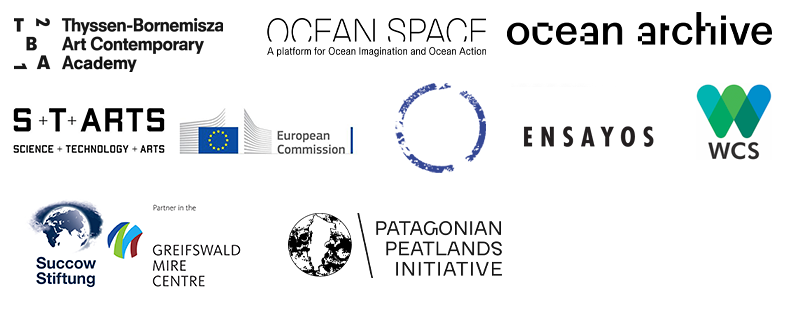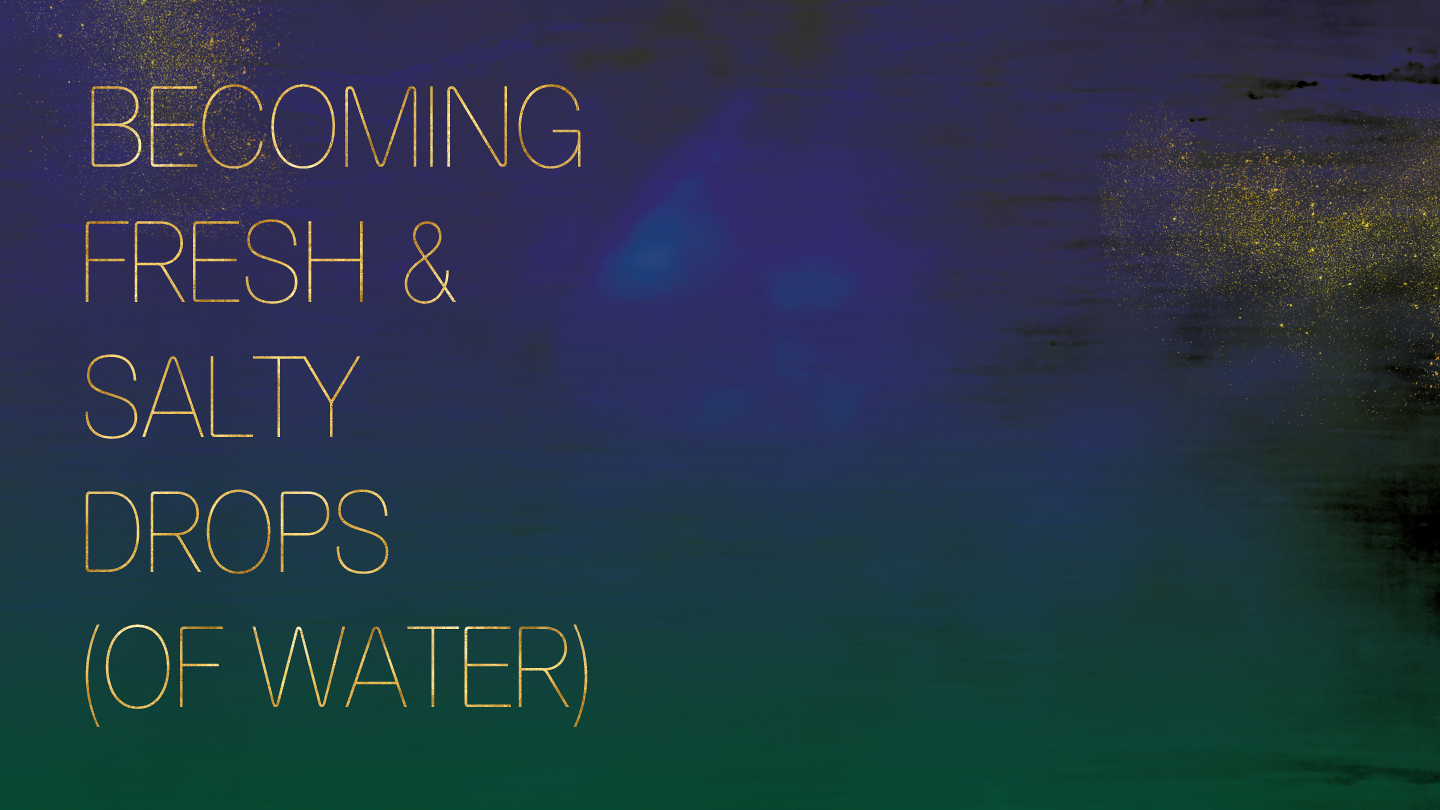June 1–22, 2022
Chiesa di San Lorenzo Castello
5069 30122 Venice
Italy
“Becoming Fresh & Salty Drops (of water)” is a month-long program celebrating the water and life forms of the Venice Lagoon, the largest coastal lagoon in the Mediterranean Sea, home to TBA21–Academy’s Ocean Space. Stories, actions, and online and live events narrate and act upon the future of the Venice Lagoon from ecological and magical perspectives.
Following the moon cycles that control the tides, the program circles back, ending on the summer solstice with the final presentation of the STARTS4Water artists in residence program, featuring Sonia Levy with Heather Ann Swanson, Meredith Root-Bernstein, and Alexandra Arènes; and Diego Delas and Leonor Serrano Rivas, and beginning with a wetland kinship project in conversation with curator Camila Marambio whose public program for “Turba Tol Hol-Hol Tol,” the Chilean Pavilion at the 2022 Venice Biennale, activates a convening on World Peatlands Day. It is followed by an educational program for World Oceans Day; a walks program, “Venice as a model for the future?,” curated by Barbara Casavecchia and Pietro Consolandi; and TBA21–Academy’s program on the intersections of food and ecology led by María Montero Sierra, Barbara Nardacchione, with Markus Reymann and Alice Ongaro Sartori in collaboration with chef Marco Bravetti and TOCIA!. This month-long program is aligned with the principles of regeneration and more-than-human rights promoted by the project Zoöp, which TBA21–Academy is a partner in.
With: pantea; Frédérique Aït-Touati; Camilla Bertolini; Isabelle Carbonell; Diego Delas and Leonor Serrano Rivas; Ifor Duncan and Heather Contant; Vera Dvale; Lodovica Guarnieri; Hans Joosten; Dianna Kopansky; Sonia Levy with Heather Ann Swanson, Meredith Root-Bernstein, and Alexandra Arènes; Radio Amnion; Reverend Houston Cypress, Bárbara Saavedra
Curated by: María Montero Sierra
A translucent drop of water, a unit that multiplies into the streams of rivers and the tides of the sea, barely shows the complexity of its matter, its fresh and salty particles, and the macroinvertebrates it hosts. Water contains in its matter embedded knowledge from its microscopic cells, geological times, and physical movements. Over time, scientific instruments such as microscopes with increasingly sophisticated lenses have penetrated what felt like invisible matter. But before technology facilitated accountable and replicable facts, magic, as the fictional space where narrations and instruments work together, paved the route. By joining the method of magic with ecology’s aims to observe the relationships between humans and environments, we enable ourselves to imagine and narrate more-than-human beings in their full agency, bridging the inapprehensible geological time and historical time.
The waters that infiltrate the mud, the swamp, the peat, and the saltmarsh are full of life. For a long time unappreciated, these watery-soil ecosystems are undergoing a revival thanks to scientists, activists, and artists joining forces to defend their unique ecological value since wetlands are, after the oceans and before the forests, the largest mass of carbon sequestration on the planet. They have held our breath for millennia. The closer attention we pay to the way the wetlands change, the more information we will have to permeate watery ways of living. In the Venice Lagoon, there are reeds and Salicornia plants spiking from the green waters and signaling the lagoon salt marshes’ ecosystem and its famous barena—the lands that emerge between tides that configure the more significant non-urban areas in the lagoon, resilient to the salt and protective from the weight and erosion of the Adriatic Sea. There are also algae and seaweed embedded within the stones of the canals and at the bottom of the boats merging the drops. These aquatic plants hold in their bodies a story of water transformation that converges the boundaries of land and open sea, but more importantly, of fresh and salty waters that define a coastland lagoon.
However, it is the magical approach that narrates and acts within these watery ecosystems—with their life forms and natural and artificial infrastructures—that prepares us for the unimaginable futures. There are stories accompanied by instruments, and instruments accompanied by sounds and words, set narratives that read data and state the “real,” but it is the learning, relearning, and the performance thereof that ground the perception and sensation in our bodies. This way we read our ecosystem. Weaving those stories, accompanying the learning process where materials speak and images flow, and growing the sensations of an expedition are at the core of the artists’ works.
Program
Signing of The Venice Agreement: Protecting Global Peatlands Locally
June 2, 7:30pm, Ocean Space
On World Peatland Day, a poetically binding declaration will be signed to inspire local action for peatland protection. The event will shed light on the fundamental role that peatlands play in regard to biodiversity, climate change mitigation, water quality, culture, and economy. With: Reverend Houston Cypress, Dianna Kopansky, Hans Joosten, Vera Dvale, Bárbara Saavedra. Curated by Camila Marambio. Co-organized by Wildlife Conservation Society (WCS) Chile, Ensayos, the Greifswald Mire Centre, and TBA21–Academy.
Register here
STARTS Academy and Educational Day on Oceans Day
June 8, Ocean-Archive.org and Ocean Space
Presentations of the works developed by the high school and MA students involved in the various workshops run by the STARTS4Water artists in residence.
Lodovica Guarnieri: When I Breathe, I Swallow the Lagoon
June 8, 6pm
Set in the amphibious Venetian Lagoon along the infrastructure of the former ENI refinery in Porto Marghera, this performance walk highlights the interconnection between bodies, environments, and power structures and rethinks responsibility in deep time. In Italian.
Register here
Convivial Tables: The Pannier of the Lagoon.
TOXICITY with chef Marco Bravetti (TOCIA!), Camila Marambio
June 9, 9pm
“Convivial Tables” is a series of closed events to provide a space to discuss the complex ties between what we eat and its ecological impact, with a particular focus on its effect on bodies of water.
More information
Cohabiting Within Wetness: “Venice as a model for the future?”
The Return Of Venetian Flat Oysters: MAREA project with Camilla Bertolini
June 10, 6pm
With Camilla Bertolini, a marine biologist and winner of a Marie Sklodowska-Curie European Fellowship at Ca’ Foscari University, organized as part of the cycle of itinerant conversations curated by Barbara Casavecchia and Pietro Consolandi.
Register here
Becoming Fresh Salty Drops
June 21, 8pm, Ocean Space, Venice
Talks, screening, and expeditions to celebrate the water and life forms of the Venice Lagoon and commemorate the conclusion of the STARTS residencies organized by TBA21–Academy that explore ecological and magical propositions for coexistence with water in the Venetian Lagoon. With Frédérique Aït-Touati, Sonia Levy with Heather Ann Swanson, Meredith Root-Bernstein, and Alexandra Arènes, Diego Delas and Leonor Serrano Rivas. Special guest: Radio Amnion: Sonic Transmissions of Care in Oceanic Space.
Register here
Online program
Throughout June 2022 on Ocean-Archive.org
New commissions and works by pantea, Isabelle Carbonell, Ifor Duncan and Heather Contant, among others.
Organized by TBA21–Academy.
Supported by STARTS.



